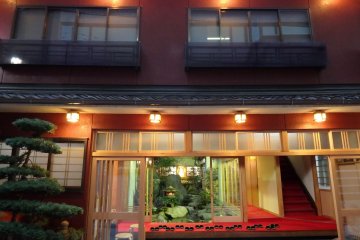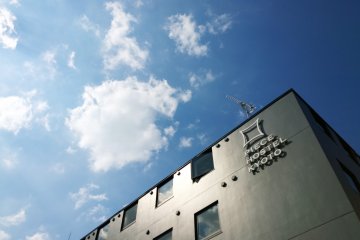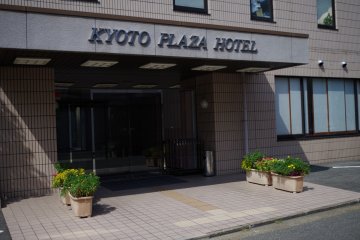
เรียวกัง Nishikiro ใกล้ๆ กับสถานีเกียวโต
Sandra Isakaเดินเพียงสามนาทีจากสถานีเกียวโต เรีวยกัง นิชิคิโระ (Nishikiro) เป็นโรงแรมเล็กๆ ที่เหมาะสำหรับผู้ที่มีงบประมาณจำกัด ที่ต้องการสัมผัสประสบการณ์แบบญี่ปุ่นแท้

Kyoto Tower is an observation tower located in Kyoto, Japan. The steel tower is the tallest structure in Kyoto with its observation deck at 100 metres and its spire at 131 metres. The 800-ton tower stands atop a 9-story building, which houses a 3-star hotel and several stores. [Wikipedia]

เดินเพียงสามนาทีจากสถานีเกียวโต เรีวยกัง นิชิคิโระ (Nishikiro) เป็นโรงแรมเล็กๆ ที่เหมาะสำหรับผู้ที่มีงบประมาณจำกัด ที่ต้องการสัมผัสประสบการณ์แบบญี่ปุ่นแท้

PIECE HOSTEL KYOTO ที่พักราคาประหยัดแต่คุณภาพระดับพรีเมี่ยม เตียงนอนแสนนุ่ม ห้องน้ำแสนสะอาด โรงแรมดีไซน์แสนเก๋ พร้อมเสิร์ฟอาหารเช้าแสนอร่อยให้ฟรีแบบทานได้ไม่อั้น

ถนนโตจิเหมือนกับเขตชิตะมะจิของเกียวโต ห่างเพียงแค่ 6 นาทีจากกลาส ทาวเวอร์ของสถานีเกียวโตแต่มันก็เหมือนย้อนกลับไปในอีกช่วงเวลาหนึ่ง

ราเม็งน้ำดำร้าน Toyama Black (富山ブラック) จาก Menya Iroha (Iroha Noodle House) (麺屋いろは) แห่งถนนราเม็งเกียวโตที่สถานีรถไฟเกียวโต

ราเม็งมันหนังหมู กินมันส์อรารมณ์ ที่ Kyoto Ramen Koji สถานีรถไฟเกียวโต ชั้น 10 Isetan

ราเม็งโตไดแห่งเมืองโทคุชิม่า (Tokushima Ramen Todai) ราเม็งอร่อยในสูตรน้ำซุปกระดูกหมูเข้มข้นที่โปะหน้าด้วยไข่ดิบ

Nishi Hongan-ji is a large Buddhist temple west of Kyoto train station. Together with Higashi Hongan-ji, together with Nishi Hongan-ji, it is one of the two temple complexes of Shin Buddhism in Kyoto. It currently also serves as the main temple of the Jodo -Shin sect, one of the largest Buddhist sects in Japan with over 10,000 sub-temples across the country and 200 temples overseas. Built in 1591 by Toyotomi Hideyoshi, the building is a great example of the architecture of the Momoyama Period and the Early Edo Period. The two largest structures by Nishi Hongan-ji are the Goeido Hall, the largest wooden structure in Kyoto, and the Amidado Hall. Nishi Hongan-ji is also one of the 17 UNESCO World Heritage Sites in Kyoto. A small Japanese garden called Shoseien is a few blocks east of Higashi Hongan-ji. Nowadays the garden with its pond and the particularly beautiful autumn colors is open to the public.

The Kamo River (鴨川), meaning “duck river,” is a prominent and scenic waterway flowing through Kyoto Prefecture, Japan. It has long been a cultural and natural landmark of the city, offering beautiful scenery and a peaceful atmosphere throughout the seasons. The riverbanks are especially popular with locals and tourists alike, who come to enjoy leisurely walks, picnics, and the seasonal beauty of cherry blossoms in spring or the cool breezes in fall. In the warmer months, many riverside restaurants open special balconies known as noryo-yuka, allowing diners to enjoy their meals with a view of the flowing river. Walkways run alongside much of the river’s course, and several spots feature stepping stones that allow pedestrians to cross on foot. Historically, the Kamo River has played a significant role in Kyoto’s development. When the Heian Capital (modern-day Kyoto) was established in the late 8th century, the river’s course was redirected to flow east of the new palace. Despite this effort, the river was prone to flooding, which became a recurring problem for the ancient capital. Emperor Shirakawa famously lamented that three things were beyond his control: the armed monks of Enryaku-ji, dice, and the waters of the Kamo River. Today, the river is more regulated, with reinforced banks and drainage systems. Parallel to it runs the Takase River, a canal constructed by merchant Suminokura Ryoi in the early 17th century to facilitate transportation and reduce reliance on the unpredictable main river. The Kamo River is also culturally significant, flowing past two important Shinto shrines—Kamigamo and Shimogamo—and through the sacred forest of Tadasu-no-mori that lies between them.

Kyoto Aquarium is located on the edge of Umekoji Park near Kyoto Station. The aquarium features 9 zones including penguins, seals and dolphin shows.